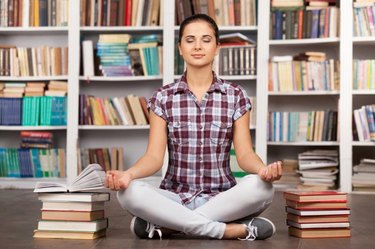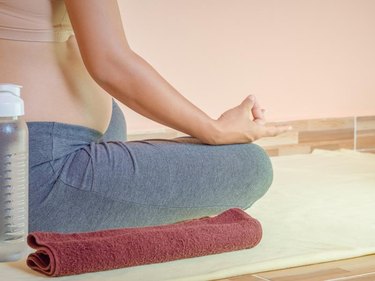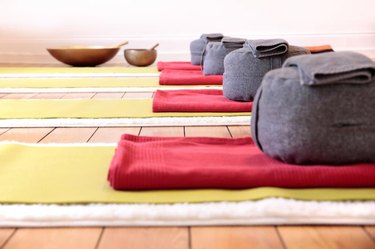
A yoga block comes in handy when you need extra stabilization in balancing poses or need to modify the angle of your knees when seated. Of course, these aren't the only uses for this valuable prop first popularized by legendary yogi and teacher B.K.S. Iyengar.
You don't always have access to a block, but that doesn't mean your practice should suffer. If you're on the road and didn't pack one in your suitcase, or have a home practice and haven't gotten around to getting one yet, that's OK. Many items can stand in, depending on what you want to use the block for.
Video of the Day
Video of the Day
Standard Block
The dimensions of a standard block are 4 x 6 x 9 inches. They're usually made of foam, cork or wood. The foam ones have a little give and are the least sturdy, but most gentle on sensitive body parts such as your back or head. Cork and wood blocks offer greater stability, but usually come with a higher price tag.
Read More: Yoga Blocks: Cork vs. Foam
You can also find blocks about half the size of standard blocks. Usually, these are available in specialty Iyengar or restorative yoga studios. Many of the listed substitutes work can stand in for this size block, too.
A Book
A hard cover book makes for a good yoga block substitute, especially if it's one you're just not into reading any more. Choose a book of appropriate size, depending on what you want to use the block for in your practice.

A larger, thicker book like an old dictionary or encyclopedia serves as a good extension of your hand, so you can better balance in Half-Moon pose. Use a book to support your forehead if it doesn't readily touch the floor, in a pose such as Child's. A stack of books lifts your hips up in Bridge. Tape old books together or wrap them in a towel to create the height you need.
Your Body
Some yogi purists challenge you to put away the props and use your body to modify. Instead of using a block to extend the floor closer to your hands in a Standing Forward Bend, simply bend your knees to reach the ground. If you use a block to reach the floor in Triangle, settle for resting your hand against your shin or thigh.
A Towel or Blanket
A towel or blanket can't provide sturdy support, but it can help raise your hips to make Seated Forward Folds more comfortable. Simply fold the fabric into a thick square and sit half-on/half-off of it to raise your hips. You'll notice bending from the hips is more accessible, comfortable and satisfying. A firm pillow is another good substitute.

Folded towels also support your outer knees when they're butterflied in a Reclined or Seated Bound Angle pose. Instead of placing blocks under your knees in Savasana to release your spine and make it more comfortable, use a rolled up towel or blanket.
A block is commonly used to create greater awareness and intensity in certain poses. A rolled towel serves the same purpose when placed between your thighs in Bridge or Dolphin pose.

Pantry Items
A family-size can of beans or pasta is just about the right height to support your hand in Half-Moon. Use a can under each hand to help you lift off in Scale pose.
If using food products puts you off, consider jugs of liquid laundry detergent or boxes of laundry powder. An empty coffee can or a cooking pot turned upside down can be used for balance, too.
Read More: Do You Need to Use a Yoga Mat?